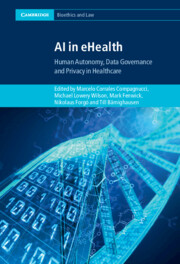Book contents
- AI in eHealth
- Cambridge Bioethics and Law
- AI in eHealth
- Copyright page
- Contents
- Contributors
- Preface
- Acronyms
- 1 Mapping the Digital Healthcare Revolution
- Part I Platforms, Apps and Digital Health
- Part II Trust and Design
- Part III Knowledge, Risk and Control
- Part IV Balancing Regulation, Innovation and Ethics
- Index
- Cambridge Bioethics and Law
- References
1 - Mapping the Digital Healthcare Revolution
Published online by Cambridge University Press: 08 September 2022
- AI in eHealth
- Cambridge Bioethics and Law
- AI in eHealth
- Copyright page
- Contents
- Contributors
- Preface
- Acronyms
- 1 Mapping the Digital Healthcare Revolution
- Part I Platforms, Apps and Digital Health
- Part II Trust and Design
- Part III Knowledge, Risk and Control
- Part IV Balancing Regulation, Innovation and Ethics
- Index
- Cambridge Bioethics and Law
- References
Summary
This introductory chapter briefly outlines the main theme of this volume, namely, to review the new opportunities and risks of digital healthcare from various disciplinary perspectives. These perspectives include law, public policy, organisational studies, and applied ethics. Based on this interdisciplinary approach, we hope that effective strategies may arise to ensure that benefits of this ongoing revolution are deployed in a responsible and sustainable manner. The second part of the chapter comprises a brief review of the four parts and fourteen substantive chapters that make up this volume.
Keywords
- Type
- Chapter
- Information
- AI in eHealthHuman Autonomy, Data Governance and Privacy in Healthcare, pp. 1 - 16Publisher: Cambridge University PressPrint publication year: 2022



